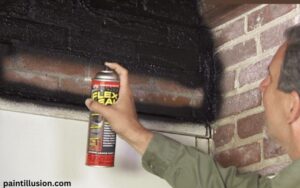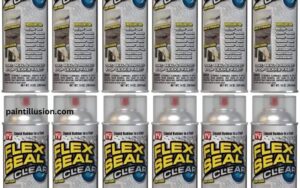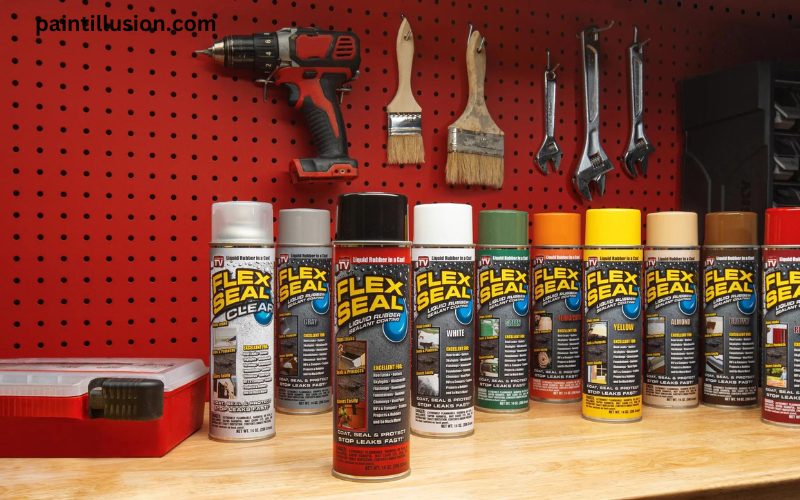Flex Seal is a popular product known for its ability to seal and protect a wide range of surfaces. It is commonly used to repair leaks, prevent rust, and provide a waterproof barrier. But what if you want to change the color of your Flex Seal-coated surface? Can you paint over Flex Seal? In this article, we will explore the possibilities and considerations when it comes to painting over Flex Seal.
Introduction to Flex Seal and its Uses
Before we delve into the topic of painting over Flex Seal, let’s first understand what Flex Seal is and how it is commonly used. Flex Seal is a liquid rubber sealant that can be sprayed, brushed, or rolled onto surfaces. It forms a durable, flexible, and waterproof barrier that can seal cracks, leaks, and gaps. It can be used on a variety of materials, including metal, wood, concrete, and more.
Flex Seal is often used in various applications, such as repairing leaky roofs, sealing gutters, fixing pipes, and even creating a waterproof barrier in ponds or pools. Its versatility and ease of use make it a popular choice for both DIY enthusiasts and professionals alike. However, one question that often arises is whether it is possible to paint over Flex Seal without compromising its effectiveness.
Can You Paint Over Flex Seal?
The short answer is yes, you can paint over Flex Seal. However, there are several factors you need to consider before doing so. The first and most important factor is the condition of the Flex Seal coating. If the Flex Seal is old, cracked, or peeling, it is not advisable to paint over it. In such cases, it is recommended to remove the old Flex Seal and apply a fresh coat before proceeding with painting.
Another factor to consider is the type of paint you plan to use. Not all paints are compatible with Flex Seal, and using the wrong type of paint can result in adhesion issues or the paint not drying properly. It is crucial to choose a paint that is specifically formulated for use on rubber or flexible surfaces. This will ensure proper adhesion and longevity of the paint job.

Factors to Consider Before Painting Over Flex Seal
Before you embark on painting over Flex Seal, there are a few key factors to consider. First and foremost, assess the condition of the Flex Seal coating. If it is in good condition, without any cracks or peeling, you can proceed with painting. However, if the Flex Seal is damaged or deteriorating, it is recommended to remove the old coating and apply a fresh layer before painting.
Another important factor to consider is the type of surface you are planning to paint over. Flex Seal is compatible with a wide range of materials, but it is always a good idea to ensure compatibility with the specific surface. Some surfaces may require additional preparation, such as cleaning or sanding, to ensure proper adhesion of the paint.
Furthermore, consider the environmental conditions. Painting over Flex Seal is best done in a well-ventilated area, as some paints may emit fumes that can be harmful if inhaled. Additionally, avoid painting in extreme temperatures or high humidity, as these conditions can affect the drying and curing process of the paint.
Steps to Paint Over Flex Seal Effectively
To ensure a successful paint job over Flex Seal, follow these steps:
1. Clean the Surface: Before painting, clean the Flex Seal surface thoroughly to remove any dirt, dust, or grease. Use a mild detergent and water, and scrub the surface gently with a soft brush or sponge. Rinse well and allow the surface to dry completely before proceeding.
2. Sand the Surface (if necessary): If the Flex Seal surface is rough or has uneven patches, sanding may be required to create a smooth and even base for the paint. Use fine-grit sandpaper and sand in circular motions until the surface is smooth. Wipe away any dust or debris with a clean, dry cloth.
3. Prime the Surface: Applying a primer is essential when painting over Flex Seal. Choose a primer that is specifically formulated for use on rubber or flexible surfaces. Apply the primer evenly using a brush or roller, following the manufacturer’s instructions. Allow the primer to dry completely before proceeding with the paint.
4. Apply the Paint: Select a paint that is compatible with Flex Seal and suitable for your desired finish. Use a brush, roller, or spray gun to apply the paint evenly, following the manufacturer’s instructions. Apply multiple thin coats rather than one thick coat for better adhesion and durability. Allow each coat to dry completely before applying the next.
5. Seal the Paint (optional): Once the paint has dried, you may choose to apply a clear sealant or topcoat to further protect the paint job. This step is particularly recommended for surfaces that will be exposed to harsh weather conditions or heavy use.
Tips for Ensuring a Successful Paint Job over Flex Seal
To ensure a successful paint job over Flex Seal, consider the following tips:
1. Choose the Right Paint: Select a paint that is specifically formulated for use on rubber or flexible surfaces. It is recommended to consult with a paint specialist or read the manufacturer’s instructions to ensure compatibility.
2. Prepare the Surface Properly: Clean the surface thoroughly and, if necessary, sand it to create a smooth base for the paint. Applying a primer is also crucial for proper adhesion and longevity of the paint job.
3. Apply Thin Coats: Rather than applying one thick coat, apply multiple thin coats of paint. This will help ensure better adhesion and a more even finish.
4. Allow Sufficient Drying Time: Allow each coat of paint to dry completely before applying the next. Rushing the drying process can result in a subpar finish and poor adhesion.
5. Consider Weather Conditions: Paint over Flex Seal in a well-ventilated area and avoid extreme temperatures or high humidity. These conditions can affect the drying and curing process of the paint.

Common Mistakes to Avoid When Painting Over Flex Seal
While painting over Flex Seal is a relatively straightforward process, there are some common mistakes that should be avoided:
1. Skipping Surface Preparation: Failing to clean and prepare the Flex Seal surface properly can result in poor adhesion and a paint job that does not last.
2. Using the Wrong Type of Paint: Not all paints are compatible with Flex Seal. Using the wrong type of paint can lead to adhesion issues or paint that does not dry properly.
3. Applying Too Thick of a Coat: Applying a thick coat of paint may seem like a time-saving measure, but it can result in poor adhesion and an uneven finish. It is best to apply multiple thin coats.
4. Rushing the Drying Process: Allowing each coat of paint to dry completely before applying the next is crucial for a successful paint job. Rushing the drying process can result in a subpar finish and poor adhesion.
5. Neglecting to Seal the Paint: While not mandatory, applying a clear sealant or topcoat can help protect the paint job and extend its longevity, especially for surfaces exposed to harsh weather conditions or heavy use.
Recommended Paint Options for Painting Over Flex Seal
When it comes to choosing the right paint for painting over Flex Seal, there are several options to consider. Here are a few recommended paint types:
1. Acrylic Paint: Acrylic paint is a popular choice for painting over Flex Seal. It is versatile, easy to use, and provides good adhesion on flexible surfaces.
2. Latex Paint: Latex paint is another suitable option for painting over Flex Seal. It is durable, easy to clean, and offers a wide range of color choices.
3. Epoxy Paint: Epoxy paint is a more specialized option for painting over Flex Seal. It provides excellent adhesion and durability, making it suitable for high-traffic surfaces or areas exposed to harsh conditions.
It is crucial to choose a paint that is specifically formulated for use on rubber or flexible surfaces. Consult with a paint specialist or read the manufacturer’s instructions to ensure compatibility.
How to Maintain and Care for Painted Flex Seal Surfaces
Once you have successfully painted over Flex Seal, it is important to properly maintain and care for the painted surface to ensure its longevity. Here are some tips for maintaining and caring for painted Flex Seal surfaces:
1. Regular Cleaning: Clean the painted surface regularly using a mild detergent and water. Avoid using harsh or abrasive cleaners that can damage the paint.
2. Avoid Scratching or Scuffing: Be careful not to scratch or scuff the painted surface. Use caution when placing or moving objects on the surface to prevent damage.
3. Promptly Address any Damage: If the painted surface gets chipped or damaged, address the issue promptly. Touch up the damaged area with matching paint to prevent further deterioration.
4. Avoid Harsh Chemicals: Avoid using harsh chemicals, solvents, or abrasive cleaners on the painted surface. These substances can damage the paint and compromise its integrity.
5. Regular Inspections: Regularly inspect the painted surface for any signs of peeling, cracking, or damage. Address any issues promptly to prevent further damage and maintain the longevity of the paint job.
Other Alternative Options for Covering or Enhancing Flex Seal
While painting over Flex Seal is a popular option for changing the color or enhancing the appearance of the surface, there are other alternative options available:
1. Colored Flex Seal: Flex Seal offers a range of colors, including black, white, clear, and more. If you are looking for a simple color change or enhancement, using a colored Flex Seal may be a convenient option.
2. Vinyl Wraps: Vinyl wraps are an alternative option for covering or enhancing Flex Seal. They come in a variety of colors, patterns, and finishes and can be easily applied to the surface. Vinyl wraps also offer additional protection against UV rays and other environmental factors.
3. Decorative Coatings: Decorative coatings, such as epoxy or decorative concrete coatings, can be applied over Flex Seal to create unique and visually appealing surfaces. These coatings offer durability, a wide range of design options, and can be customized to suit your preferences.
Consider your specific needs and preferences when exploring alternative options for covering or enhancing Flex Seal.
Conclusion
In conclusion, painting over Flex Seal is indeed possible, but it requires careful consideration and proper preparation. Assess the condition of the Flex Seal coating, choose the right type of paint, and follow the necessary steps to ensure a successful paint job. Remember to properly maintain and care for the painted surface to prolong its longevity. If painting is not the desired option, consider alternative options such as colored Flex Seal, vinyl wraps, or decorative coatings. With the right approach, you can transform and enhance your Flex Seal-coated surface to suit your desired aesthetic.


Interesting blog. I learned. Nice work.